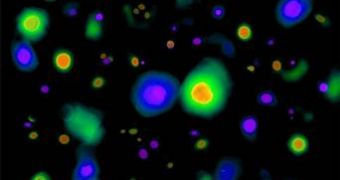The microwave background radiation is a remnant of the cosmic radiation of Big Bang. It was discovered in 1965 by scientists at Bell Laboratories, almost by mistake during a satellite communication experiment. This electromagnetic radiation fills the entire universe, has a thermal 2.725 kelvin black body spectrum, which peaks in the microwave range at the frequency of 160.2 Ghz and makes up a picture of the early universe, which corresponds with the Big Bang theory, which says that the entire visible universe has originated from a singularity.
The discovered giant cold spot might be a space-time fabric defect. As the universe cools and expands itself, elementary particles are created from exotic ones through a process resembling that of gas-liquid-solid transition of matter on Earth.
Scientists can not yet agree upon the origin and nature of this cold spot. Some say it is just a random variation in the cosmic microwave background, or possibly a texture, a three-dimensional blob-like structure inside which no stars, or any form of matter or even dark matter exists, but an unknown substance thought to exist in the universe and never before detected.
A cosmic texture would lead to light passing through it to bend in different ways, a feature that could be detected in future experiments.
The fact that a structure one billion light-years across, completely void could exist in our Milky Way galaxy is incredible, but the idea that this strange cold spot could be a random temperature fluctuation in the CMB has a probability of only 1 percent.
"So the texture hypothesis is actually very testable." says Neil Turok of the University of Cambridge.
In the early 90's a group of scientists showed the way textures form and could have formed in the early universe and how they could actually exist in our times.

 14 DAY TRIAL //
14 DAY TRIAL //